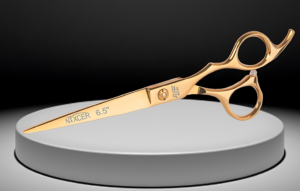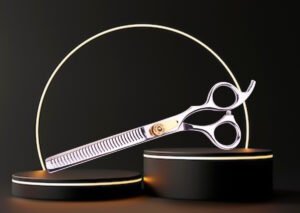Balance is a critical factor that directly impacts how comfortable and efficient a pair of scissors will be in use. Properly balanced scissors.
- Reduce hand fatigue
- Enhance precision
- Improve speed and efficiency
- Prevent injury
Here is a step-by-step guide to perform a balance test on your hair cutting scissors.
Step 1: Balanced Scissors: Prepare Your Scissors
Use a soft cloth to remove any hair, dust, or residue on the blades. Clean scissors ensure that nothing interferes with the balance test. Apply a small amount of scissor oil at the pivot point and along the blades. This helps maintain smooth blade action and prevents friction that could affect balance.
Use a scissor tension key or screwdriver to check the tension. The screw should be tight enough that the blades don’t fall open freely when held horizontally, but loose enough to open and close without resistance. If the tension is incorrect, it may give a false impression of balance. Too tight, and the scissors will feel stiff; too loose, and they may feel unstable.
Step 2: Balanced Scissors: Position Your Scissors
Place your index finger under the pivot screw where the blades meet. This is the scissor’s natural balance point. Positioning at this point allows you to evaluate the weight distribution between the handle and the blades accurately.
Opening the blades at this angle helps reveal imbalances that may not be visible when the blades are closed. It mimics the scissors’ usual working position, giving a more realistic assessment of their performance during cutting.
Step 3: Balanced Scissors: Balance Check
Let the scissors rest naturally on your finger. Observe how they behave when balanced at the pivot point. Take note of whether the scissors stay level or if one end starts to dip downward.
The scissors remain horizontal, indicating even weight distribution. This balance ensures that the scissors will cut consistently without pulling or dragging on the hair. If the blades tilt downward, it indicates that the scissors are front-heavy. This can lead to faster hand fatigue because it requires extra effort to control the blade’s movement, particularly during precise or angled cuts.
If the handles tilt downward, the scissors are handle-heavy. This imbalance makes the scissors feel awkward, often requiring stylists to adjust their grip frequently, which can impact the flow and accuracy of the cut.
Step 4: Balanced Scissors: Perform a Cutting Test
Select a small section of Professional Hair Cutting Scissors or use a strip of tissue paper to perform a cutting test. The aim is to feel how the scissors perform in real-world conditions. Start with a few straight cuts, then try different cutting techniques, such as point cutting or slide cutting, to see how the scissors respond.
A balanced pair of scissors will cut smoothly, without pulling or snagging. The weight distribution should feel natural, allowing for precision without adjusting your hand position constantly. If the scissors feel heavy on one side, you might notice uneven cuts or dragging sensations, indicating that the scissors are not well-balanced and may need further adjustment.
Step 5: Balanced Scissors: Adjust as Necessary
Sometimes, balance issues can be corrected by fine-tuning the tension screw. Small adjustments can make a noticeable difference in how the scissors feel and perform. Avoid over-tightening, as it can cause additional stress on the hand and affect balance. Conversely, a loose screw can cause the blades to misalign, leading to inconsistent cutting.
If the scissors remain imbalanced after testing and minor adjustments, seek professional servicing. A skilled technician can assess blade alignment, tension, and handle condition to ensure your scissors perform optimally. Regular maintenance, including sharpening and tension adjustment, helps maintain the balance and longevity of your scissors.
Additional Tips to Ensure Balanced Scissors
- Keeping your scissors clean and lubricated is essential to maintain their balance and performance. Regular oiling at the pivot point reduces friction, ensuring smooth blade action.
- Always store your scissors in a protective case or pouch to avoid drops or impacts that can affect balance. Improper handling can misalign the blades, leading to balance issues.
- Periodically perform balance tests and inspect your scissors for signs of wear, such as loose screws or damaged blades. Early detection of balance problems can prevent more severe issues that affect cutting performance.
Final Thoughts
A balance test is an essential procedure that every stylist should regularly perform to ensure their scissors are functioning at their best. Properly balanced scissors not only enhance cutting precision and efficiency but also protect the stylist’s hand health by minimizing strain and fatigue. By regularly testing and adjusting your scissors, you can maintain a professional standard of cutting, providing a comfortable and precise cutting experience for both the stylist and the client. Remember, investing time in maintaining balance is investing in your craft, ensuring that every cut is as effortless and perfect as possible.



